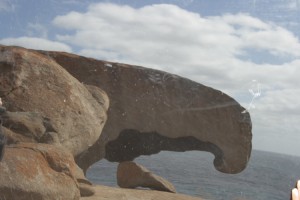His feigned disinterest was parodied by his camera with the big lens. His marked territory was signified through the viewfinder of the camera, a coded reality immediately understood. A prefigured capture.
My reflection was barely managed. The wind buffeting the reflective panel which had few places to be rested, the sun too low and on the wrong side. These conditions determined my choices. Along with the distinctive rock pictured on the sign at the entry my frame was predetermined. The second order signification already obvious—including the emphasis on the sign of danger with several deaths occurring at the rocks—through tourist brochures, maps, spoken recommendations and most obviously the name.
The visit became one of consciously acting out a mythology in the third degree—an exercise in creating a paradox out of a paradox. Though not so much irony as a willful self-parody of taking the body of the author hand in hand with ‘a’ self-reflected tourist. Putting myself in a position of knowing what to expect and what to do because of the doxa of received signification, but acting out this process on the inside and outside, then reflecting it back as a gesture of unprovability. Did I actually visit this place? Was I the tourist in the title?
As Barthes notes, it is our culture, history and the tourist industry which is the author of this image as a concept of preconditions, of signifiers seamlessly adhering to the referent. There is no question of meaning, for the concept of ‘tourist’ is pre-established, the idea of representation is understood as the seemingly ‘unique’ realization of proof through the lens. I—tourist and critical interpreter—can confirm my presence simultaneously as a reality and as the other; but I know there is in fact only the ‘other’.
My ‘other’ is an inversion, a paradox of a recognised paradox (the strangeness of the tourist). The uselessness of a poorly taken image—a child ‘playing’ with the camera, marks on the lens, unwanted intrusions, wrong lighting—all possible signifieds for a ‘normal’ image. But why would a tourist with such a good camera, in control of his territory on a scripted and ‘intentional’ trip make such a poor image, and further not immediately delete it from the camera’s memory?
Instead, the image is reversed and signified as a fallacy; the marks, the distorted horizon, the ‘off’ colour, the ‘operator’ in the image, someone’s fingers. But how can the ‘operator’ be in the image? Are those fingers holding a print?
My culture, so says this image, pierces my authorship; inverts it from the black, from the death where the punctum is the excrescence of my body. Finger tips, touch, determine the limits of my desire. The representation is inconsequential, already dead.
Acting, 2010

